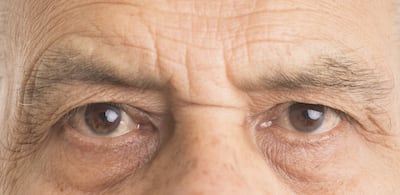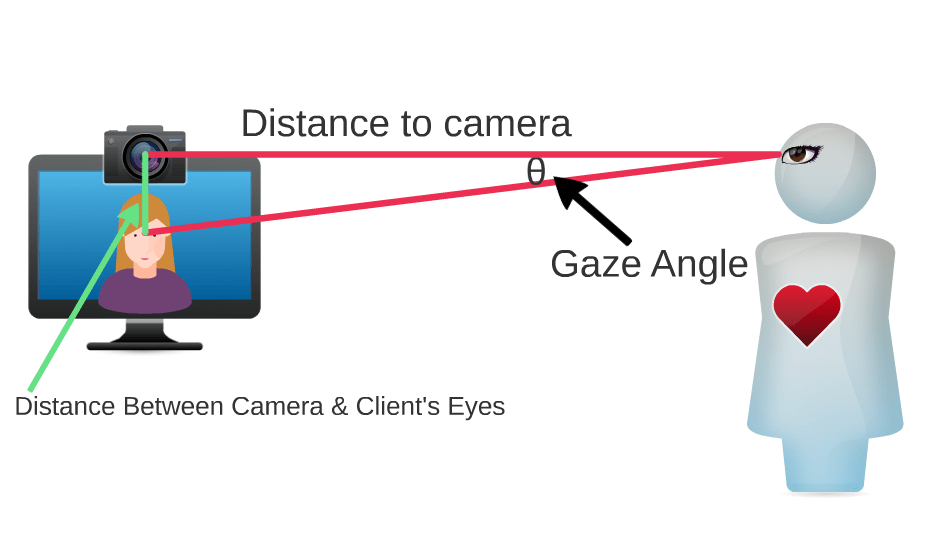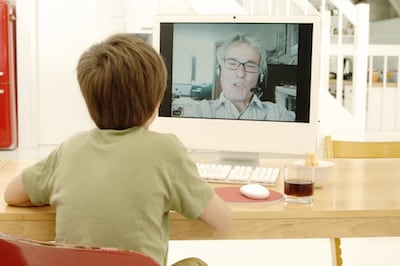“I’ll start doing online therapy when they can put the camera right in the middle of the screen — where my client’s eyes are. Otherwise, how can we do eye contact?”
— One of my beloved mentors
 Apologies to that mentor, because I’m about to explain why human perception of eye contact is more flexible than we tend to believe. I’ll also give some advice on leveraging that flexibility in video-based therapy.
Apologies to that mentor, because I’m about to explain why human perception of eye contact is more flexible than we tend to believe. I’ll also give some advice on leveraging that flexibility in video-based therapy.
Eye contact has been a telemental health-related hobgoblin to the mental health community for about as long as “Skype Therapy” has been a phrase. Therapists quite rightly note that one can’t look at the camera and the client at the same time. So, it has often been concluded, how can real therapeutic eye contact be achieved?
The argument seems valid on the surface, and can create justified angst regarding the full effectiveness of videoconferencing as a therapy delivery medium. Fortunately, research has shown that eye contact doesn’t work quite the way we may naturally assume. By leveraging this research, we can achieve eye contact and empathic facial expressions quite well over video.
What Is Eye Contact, Logistically Speaking?
How do you know when you’re making eye contact with another person? How would you consciously describe the process?
An early (1963), and heavily cited, study by Gibson and Pick used a method of testing observed eye contact by having one subject look at points on another subject’s face that extend out from the bridge of the observed subject’s nose.
The method went on the assumption that fixing one’s vision on the bridge of someone else’s nose should, largely speaking, be perceived as eye contact (and it was perceived that way 84% of the time.) And as they expected, perceived eye contact got less and less likely as the observer looked at points further out from the bridge of the observed person’s nose.

Since then, a number of researchers have made refinements in our knowledge about how we perceive when someone is making eye contact with us.
Some cognitive-interpersonal observations:
- We tend to perceive eye contact as a yes or no proposition, even though the actual focus and angle of someone’s gaze can vary on a spectrum. When eye contact is perceived to be made, we tend to simply decide it is being made without caveats or qualifications. (Chen, 2002)
- Perceived eye contact is not just an issue of optics — it is also socially mediated. When we feel like the other person is doing a thing where eye contact would be normal, such as expressing empathy, we’re more likely to perceive them as making eye contact (so long as their gaze direction is within a reasonable range, of course.) (Chen, 2002)
Some anatomical findings:
- Perception of eye contact can be modified by whether or not one’s eyes are focused together on an object. Professional actors will tell you that just looking at a camera lens isn’t quite enough to make it look like eye contact. The general advice is to focus on a point just behind the camera lens. Doing so focuses your eyes and makes it clearer where you are looking.
- Interestingly (and vital to our conclusions), it is easier to notice when someone’s gaze is fixated on your hairline than when it is fixated on your mouth. (Lord & Haith, 1974)
And lastly, some findings important to eye contact over video:
- Humans can perceive changes in eye fixation and gaze angle over video. The medium doesn’t curtail our ability to perceive if we’re being looked at or not. (Gale & Monk, 2000)
- Rotating one’s eyes downward is less noticeable than rotating them up or to the side (this reinforces the finding that we notice less when people look at our mouths.) We can rotate downward a fair amount before others notice. Placing a camera at our eye level and on top of the screen, while gazing down to look at the client below the camera, allows a certain amount of gaze angle that the person on the other end of the call doesn’t perceive. (Chen, 2002)
- When the camera is placed at eye level, and our eyes are rotated downward to look at the screen, the angle of our eyes’ rotation is called the “gaze angle.” Humans generally can’t perceive a downward gaze angle of less than 5-7 degrees. (American Telemedicine Association, 2009)
Our free, informative articles are brought to you by Hushmail,
who is offering our readers 15% off for life!
Wondering why this is here? See our sponsorship policy for details.

 Roy says: Hushmail is one of several secure email options that serves health care practitioners like us. Hushmail is highly trusted, affordable, includes secure web forms that accept e-signatures, and has earned a recommendation from us for use by mental health professionals. Learn more about Hushmail for Healthcare and get 15% off for life.
Roy says: Hushmail is one of several secure email options that serves health care practitioners like us. Hushmail is highly trusted, affordable, includes secure web forms that accept e-signatures, and has earned a recommendation from us for use by mental health professionals. Learn more about Hushmail for Healthcare and get 15% off for life.
5-7 Degrees Of Gaze Angle Works For Eye Contact? Time To Do Some Geometry!
Clap if you remember this acronym from geometry class: SOHCAHTOA. (I didn’t remember it, either. I had to look it up on homework helper websites!)
If a downward gaze angle of up to 5-7 degrees won’t disturb the client’s perception of eye contact, then we can come up with some concrete numbers regarding where to position a client’s image in our screen and how far back from the camera we should sit. Check out this diagram:

Note: The red lines represent distance to the computer, and not the therapist shooting eye lasers
The gaze angle can be calculated if we know the therapist’s distance to the camera and the distance between the camera and the client’s eyes on the screen. Note that this calculation depends on the camera being placed at the therapist’s eye level and directly above the image of the client.
The aforementioned geometry mnemonic, SOHCAHTOA, helps us remember if we need cosines, sines, or tangents in order to “solve for theta,” as they say. But I’ll skip all that and just give you some guidance:
- The further down the client’s eyes are from the camera, the further back you need to sit in order to keep the downward gaze angle below 7 degrees.
- Reducing the size of the client’s image and moving it up closer to the camera reduces your gaze angle, but making the client’s image bigger on your screen makes it easier for you to see the client’s facial expressions.
- Fortunately, making the client’s image bigger also lets you sit further back, which also reduces your gaze angle.
- When you don’t have enough space to sit farther back, you may need to reduce the size of your client’s image on the screen so that you can see their whole face and your gaze angle remains reasonable. Depending on your depth of history with the client and the conditions you’re working on with them, this may be more or less a desirable situation.
- If the client’s eyes are 6 inches below the camera, your gaze angle will be 7 degrees if you are sitting 4 feet back from the screen. To get your gaze angle below 5 degrees, you would need to sit back at least 6 feet.
- Sometimes clients don’t set the camera at eye level and they leave a lot of space on the screen above their heads. This makes you look further down to see them. If this situation is straining your ability to keep a reasonable gaze angle, it might be good to ask the client to adjust their camera.
- And the real big tip: gaze angle is created by the rotation of your eyeballs. Sitting further back means less eye rotation and thus less angle. A nice thing about cameras is that they can zoom in on the subject. So if you sit further back but then zoom your camera in on your face, the rotation of your eyes will be within our acceptable range due to the distance, while the zoom makes you appear closer to the client. Clearly, a small monitor will make this technique less likely to work.
It’s All About Attitude
 Therapy isn’t just about geometry, of course. Eye contact is a perception thing, and it’s mostly important to us because it’s part of expressing empathy and caring (as well as assessing the client’s mental state, of course.) Remember in the section above when we saw that people are willing to believe you’re making eye contact when you’re doing things they associate with eye contact?
Therapy isn’t just about geometry, of course. Eye contact is a perception thing, and it’s mostly important to us because it’s part of expressing empathy and caring (as well as assessing the client’s mental state, of course.) Remember in the section above when we saw that people are willing to believe you’re making eye contact when you’re doing things they associate with eye contact?
So another technique for getting around the oddness of eye contact on video is to simply be empathic and caring! Don’t hold back from it, and let your client hear your empathic voice and see your empathic face and (upper-) body posture.
Be creative, be compassionate, and get into the process of therapy using this medium. Not only will it help the client see you as making eye contact, it will also make them feel cared for. And that’s what we’re here to do, anyways!


Hi Roy,
I am very distressed about your depiction of a therapist shooting eye lasers at the client. Such behavior on the part of a therapist should absolutely not be… oh, wait. Just read the disclaimer. Nevermind.
*phew* So glad I included that disclaimer, then. I was worried about that one! ;)
I’m curious if you have ever experimented with teleprompter hardware, like ProPrompter Desktop (expensive) or ProPrompter Pro2 U-Mount for Tablets and Smartphones (more reasonable).
I haven’t, no. Interested in your experiences if you try it!